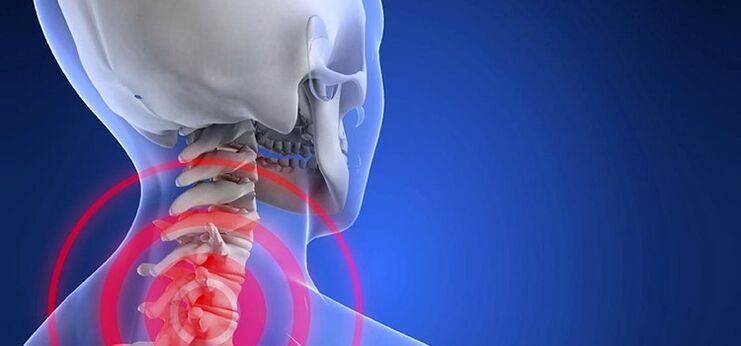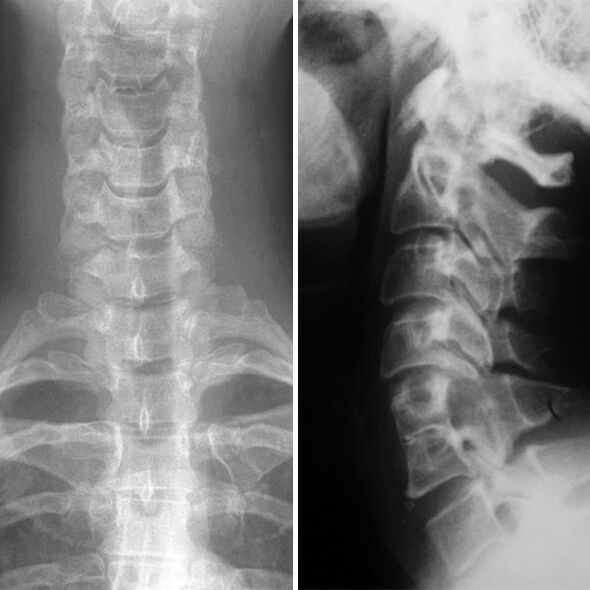
The osteochondrosis of the cervical region is one of the most common diseases of the spine, which can be explained by the great mobility of this part of the body.As the disease develops, severe pain occurs, which significantly worsens the quality of human life.That is why it is so important in the first manifestations of the pathology to consult a doctor.
Osteochondrosis clinic of the cervical column
The violation is progressive and consists in the appearance of distributing changes in the discs of the spine.There are seven vertebrae in this place that provide free head movements.Due to the increase in physical effort or insufficiently strong muscles, this backbone is often undergoing such violation.
With the development of the disease, the metabolic processes in the column are altered, the resistance and elasticity of the intervertebral disk disappear, and the increased loads lead to the fact that the cracks occur in the fibrous ring.As the process develops, protuberance or hernia appears.
The degree of development
- The first grade.The disease causes a small symptom.A person feels small pain in the neck, increasing with turns of the head.During the exam, the doctor can identify a small muscle voltage.
- The second grade.This form is characterized by tangible pains, and can give it to hand or shoulder.This is due to a violation of the height of the disk that causes nerve pinch.Pain syndrome is strengthened when the head moves.Such a state is characterized by headaches, greater weakness, decreased work capacity.
- The third grade.The manifestations of anomaly increase many times, and pain is constantly present.They can feel not only in the neck itself, but also to affect the shoulder or arm.The formation of a hernia leads to the weakness of the hands.A person complains of chronic fatigue and dizziness.In the exam, the doctor can detect a violation of neck mobility.In addition, the patient has pain during palpation.
- The fourth grade.At this stage, the intervertebral disc is completely destroyed, which leads to the formation of connective tissue in place.Also in the patient, dizziness increases significantly, coordination of movements is altered and there is noise in the ears.Such symptoms are a consequence of the use of the vertebral artery in the pathological process: it is responsible for cerebellum nutrition and brain area.
Reasons
Under the influence of several factors, the load on the cervical compartment increases.The muscles are trying to compensate for this process, which causes cramps and problems with blood circulation.Because of this, degenerative processes arise.
The main causes of the disease are the following:
- motor activity deficiency;
- Metabolism violation;
- incorrect posture;
- Overweight;
- scoliosis;
- systematic muscle tension;
- stressful situations;
- Displastic abnormalities of connective tissue;
- problems with blood circulation in the neck;
- inheritance;
- un controlled physical activity;
- Abnormalities of the spine.
Contrary to popular belief, osteochondrosis can identify not only in older people.Today, such rape is not uncommon, even among children and adolescents.In addition, the number of disease cases in people is 18-30.
Symptoms and signs of the disease
These or other symptoms of osteochondrosis are present in almost all people.If they are associated with pronounced pain, you should immediately consult a doctor.Pathology signs include:
- Neck pain.They can yield to the back of the head, shoulders, eyes or ears.Very often they feel during the movements.Sometimes there is a click pain.
- Hand pain.The discomfort can also be felt in the shoulder area, the brush, the forearm, and remains even at night.
- Violation of the activity of the hands and fingers.A person can lose the sensitivity and strength of the muscles.
- Muscle tension in the morning.
- Noise in the ears.
- HeadachesAs a rule, they begin to feel on the back of the head, and then feel in temples and crown.
- Numbness and tingling in the limbs.
- Fainting, dizziness, darkening in the eyes.Such signs often appear with careless movements of the head.
- Language numbness.
- Worse ear and vision.
- Pain in the heart area.
- Increasing connective tissue size in the neck.
- Sleep disorders, memory, attention.
- Change the voice: the appearance of Ronca, weakening of the voice, etc.
Cervical osteochondrosis symptoms
The violations of this column are characterized by such manifestations:
- systematic headaches;
- Intercostal neuralgia;
- pressure drop;
- loss of movement coordination;
- dizziness;
- chronic fatigue;
- heart pain;
- infectious pathologies;
- flashing points in front of the eyes;
- noise in the ears;
- fingertips of fingers;
- Pain in the hands and shoulders.
This form of osteochondrosis causes many syndromes and can generate problems in the functioning of certain organs.
For example, this pathology often causes heart disease.Therefore, if these symptoms occur, you should immediately consult a doctor.
Syndromes
In addition to the general manifestations, several syndromes are characteristic of cervical osteochondrosis.Thanks to these signs, it is possible to make a precise diagnosis and choose therapy.
Koreshka
This condition is also often called cervical radiculitis.The rest syndrome is the result of the pinched nerves on the neck.As this process progresses, the pain extends down, reaching the shoulder blades.They can affect the forearms and fingers.Sometimes patients complain about chicken and tingling skin.
The manifestations of the violation are determined by the location of the pathology.Then, by pinching the roots of the central nerve, swelling occurs, which affects large fingers, means and indexes.If the roots of the nerve of the shoulder are affected, the process touches the little finger and the ring finger.
Irritor-reflex
This condition is characterized by severe pains that are located in the neck or neck.Often discomfort intensifies after an acute movement.As examples of such a state, it is worth giving pain after sleep, when the patient turns his head sharply.The inconvenience can also be felt in the chest or shoulder.
Vail artery syndrome
The main symptom are the headaches that are pulsating or burning.They often apply to the back of the head, darkness, whiskey.In addition, discomfort is often felt on eyebrows.Pain syndrome intensifies after a long movement.Discomfort also increases after being in an awkward position.With a decrease in immunity, nausea, fainting, auditory problems and violations in the operation of the vestibular apparatus are possible.In addition, vertebral artery syndrome often causes vision problems.Eye pain may appear.
Cardiac
First, the symptoms of angina sinning appear.That is why there is a threat of an unplunting treatment of the angina of pectoris instead of eliminating the main cause of discomfort.
The development of the cardiac syndrome is caused by a pinch of diaphragmatic nerve roots or chest muscles.Party -shaped pains that feel for a long time can appear.In addition, discomfort increases with sneezing, coughing and inaccurate movements of the head.
This syndrome is accompanied by tachycardia and extrastole.In this situation, pain is not reduced even after using antianginal medications.If you make a cardiogram during an attack, there will be no symptoms of blood circulation problems.
Complications and consequences
The most dangerous complications include:
- The protuberance of discs that cause the formation of a hernia.
- Disc gap with pinch of nerves and blood vessels.In this state, the spinal cord can be squeezed, which is very threatening.
- Radiculopathy: violation of nerve roots.
- The formation of osteophytes: the peaks called in the vertebrae.As a result, paresis and paralysis are often produced.
Dun osteochondrosis can be a dangerous complication of this form of Duchitren.
In this case, a person's tendons lose the ability to stretch.As a result, the fingers are deformed and cannot work properly.

Diagnosis
To diagnose a violation, you must communicate with a neurologist.The specialist will prescribe these types of research:
- radiography;
- computerized tomography;
- Magnetic resonance tomography.
To evaluate the condition of the cervical vessels, ultrasound dopplerography can be performed.For problems with blood circulation, it is worth carrying out the resolezefalography.You must also communicate with the optometrist, who will carry out the inspection of the bottom of the eye.
How to treat
To obtain the desired results, the treatment must be integral.To do this, use medical and non -fidic techniques.Doctors often recipe medications that help eliminate pain and inflammation.
Be sure to accept funds to normalize brain circulation.If the pathology causes muscle tension, it must take relaxing agents.In addition, vitamin complexes are very useful.
The effects of physiotherapy play an important role in the treatment of the disease.Paraffina and electrophoresis applications are especially useful.In addition, water procedures, hirudotherapy, massage, acupuncture, magnetotherapy are also often prescribed.However, the most effective treatment method is considered therapeutic gymnastics.In especially difficult situations, it cannot do without the surgical intervention.
The osteochondrosis of the cervical column belongs to the category of sufficiently dangerous disorders, because not only causes pain, but can also lead to the development of serious consequences.To avoid the appearance of complications, if any discomfort in the neck, you should seek medical help.



































